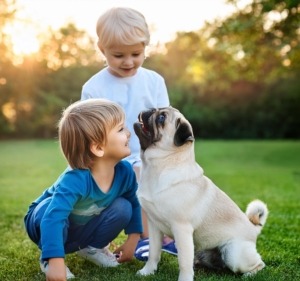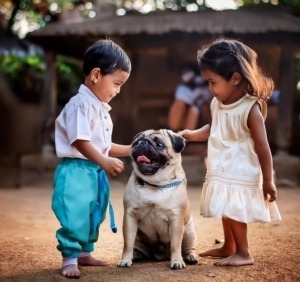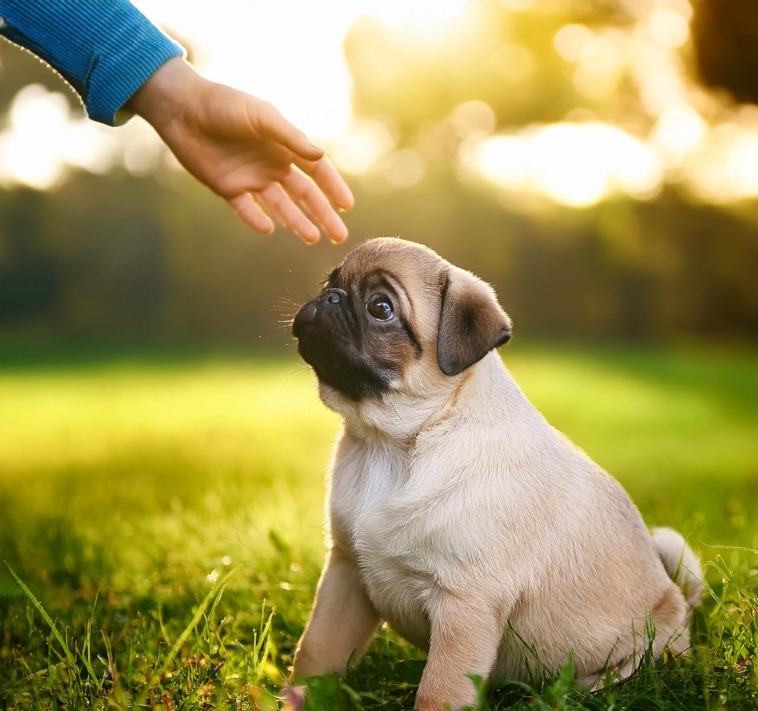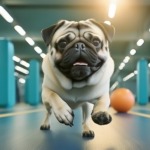Last updated on September 30th, 2024
Here’s an overview:
Introduction to Pug Socialization When it comes to pugs
Understanding Socialization Windows
Navigating through new environments
Handling fear and anxiety in pug puppy socialization
Training consistency and reinforcement
Using Rewards And Positive Reinforcement
Addressing Behaviors in pug puppy socialization
Gradual Exposure: Introduce new places, people or animals bit by bit.
When To Seek Professional Help in pug puppy socialization
Conclusion: Nurturing a Well-Adjusted Pug Puppy
Introduction to Pug Socialization When it comes to pugs
A Well-Socialized Pug Puppy Produce Goals Introduction to Pug Socialization When it comes to pugs, socialization is necessary so that they grow up into a confident and well-rounded pet. Early contact with various settings, people, and other animals sets the stage for future interactions.
- Environment Exposure: Take the puppy to different locations such as parks, busy streets or quiet places. Encourage them to explore and build confidence.
- Interactions with Humans: The dog must meet different age groups from kids to older adults. Favorable experiences will involve gentle touches or play bites.
- Other Animals: Plan meetings between other dogs or any pets available in the home. These should be closely supervised so as breed friendly manners among them all Effective socialization reduces fear and aggression resulting into a happier pet!
Understanding Socialization Windows
These periods help maintain well-adjusted dogs among pups because each period has its own unique characteristics regarding growth.
- Neonatal Period (0-2 weeks): Avoid excessive handling; provide warmth and basic care only
- Transitional Period (2-4 weeks): Eyes open; hearing begins; handle gently; expose mildly
- Socialization Period (4-12 weeks): Majority of socialization happens here.
Different people, places and other animals should be brought into a dog’s life in this time.
- Juvenile Period (3-6 months): Reinforce the teachings learnt; up the level of exposure to new situations Lack of attention to such windows may lead to behavioral problems later in life Early Experiences: Building Positive Associations The early experiences are what will determine if your pug puppy will become well-adjusted. Foster positive associations by introducing the pup to different environments, people and other animals thereby make each encounter pleasant through treats and praise.
- Gradual Introduction: Begin in peaceful settings before moving on to busier ones.
- Start Early: Start allowing your pug access different kinds of individuals e.g children, adults or old people.
- Positive Reinforcement is Key: Use rewards like treats and praises to appreciate good interactions with people, helping your pug associate meeting new people with pleasant experiences.
- Supervised interactions: Always conduct the introductions with an eagle eye to avoid any potential stress or fright.
- Diverse settings: To establish the pug’s adaptability, encourage meetings in different places like parks, streets and even homes.
- Gentle exposures: Let the pug find strangers at its own pace without forcing it on them.
Navigating through new environments
Introducing a pug puppy to several places at an early age ensures they grow up adaptable and confident. Start by including short visits to different settings such as parks, city streets or quiet neighborhoods under supervision.
- Control exposure: Gradually increase the level of stimuli.
- Reward based training: Treats and positive reinforcement are used.
- Behavioral observation: Monitor your pug’s reactions and comfort zones
- Sound introduction: Make them familiar with sounds like traffic or household noises.
- Meet other people: Allow your pug to interact with various individuals in a friendly manner.
Early experiences go a long way in reducing anxiety later in life and encouraging exploration without fear.
Exposure to other animals
It is important that you introduce your pug puppy to other animals. Early exposure helps reduce fear of future aggression.
Start off with;
- Household pet: slowly introduce puppie(s) into existing pets at home for supervised interaction,
- Pug Puppy classes: Register for some puppy socialization classes where you get controlled exposure to other dogs,
- Kitten and small animals: if possible arrange supervised encounters with kittens or small animals,
- Farm visits: going down on farms can acquaint the doggie with large animals like horses, cows, and chickens etc.,
To ensure positive experiences and avoid traumatic events careful monitoring and positive reinforcement must be used,
Play dates with other puppies
Through organized play dates, introducing your Pug puppy to other puppies creates excellent opportunities for socialization. All puppies need vaccinations before participating in this activity.
- Choose appropriate playmates: same size pups who have similar temperaments make ideal playmates.
- Supervised sessions: Any roughhousing should be stopped by supervising their play.
- Neutral territory: Use neutral areas to avoid territorial behavior.
- Short sessions: Begin with a 15 – 20 minute play date at most as they get used to each other.

Frequent interaction with other puppies helps develop social skills, decrease fear and aggression, and it tends to promote general health among your Pug dogs.
Handling fear and anxiety in pug puppy socialization
Pug puppies sometimes become frightened or anxious when exploring their surroundings. This means that such feelings need proper addressing:
- Create positive associations: Combine new experiences with treats and praise,
- Gradual exposure: Slowly introduce them to new stimuli,
- Consistent routine: Have a predictable daily schedule which gives security,
- Calm behavior: The owner needs to stay quiet in a composed manner for security purposes,
- Desensitization: Make them go through horrifying situations under controlled, brief interactions that take time before expanding duration,
Understanding these needs and attempting to address them will lead into a self-assured pug puppy.
Training consistency and reinforcement
A consistent approach is required when training your pug puppy. A simple, clear command helps ensure that the dog knows what is expected of it. Training consistency and reinforcement for pugs puppy socialization. Repetition leads to familiarity and responsiveness. Treats or praise are types of positive reinforcement which are used on good behaviors. Some examples of this include;
- Consistent commands: Use the same words for commands.
- Routine practice: Regular training sessions help memory retention.
- Positive reinforcement: Reward good behavior immediately.
- Patience: punishment would never be justifiable due to its link with anxiety related issues, thus one should be patient enough instead,
- Short session: Keep training intervals short so you can concentrate better during those periods of time.
By using these methods, the pup learns essential socialization skills effectively.
Using Rewards And Positive Reinforcement
It is highly important in successfully raising a pug puppy that one uses rewards and positive reinforcement during socialization.
- Praise through Talk: Verbally compliment the puppy for good behavior.
- Rewarding with Treats: Give small, healthy food rewards for calm interactions.
- Touch Rewards: Soft strokes and tummy-rubbing can strengthen good action.
Making routines stick requires consistency in making them stick as well as incorporating rewards. “This approach helps foster a trusting relationship and promotes better-rounded social skills”.
Addressing Behaviors in pug puppy socialization
To address behavioral issues, it’s important that the owner use proactive training methods. Pugs often need clear limits and consistent rules.
- Positive Re-enforcement: Appreciation of positive behavior by giving out food treats, praise or playing together.
- Consistency: Have consistent rules and training schedules to prevent confusion on the part of the puppy which may lead to undesirable behaviors.
- Socialization Experiences: Lower pug’s fears and aggressive tendencies by allowing it to interact with people from diverse backgrounds.
Professional Help will be needed when:
The owner should ask for a professional dog trainer if there are lasting problems.
Supportive – Avoid punishing; rather, re-direct negative acts calmly and with patience.
One should exercise patience since these measures support a well-behaved pug dog with emotional balance.
Establishing a Daily Routine
In order to ensure the well-being of a Pug puppy as well as its integration into society, one needs to set up daily routine. Establish regular feeding times so that you get proper nutrition every day. Include daily walks in different places for the puppies’ growth rate.
Major Features in pug puppy socialization:
Interval of Eating – this is where puppies learn to have control over themselves, so they don’t develop anxiety disorders during their adulthood lives. Exercise Regimen – everyday walk develops physical health plus interaction with other environments. Time for Socializing- dedicate time for human interaction plus other dogs Short Training Sessions include brief obedience sessions that reinforce good behavior and commands Relaxation: make sure the puppy has enough rest not to be over excited and stressed.
The Role of Patience during Socialization:
In terms of successful socialization, patience plays a key role in developing a well-rounded pug puppy. Random sudden occurrences may result in fear or anxiety thus harming a puppy’s growth process.
Gradual Exposure: Introduce new places, people or animals bit by bit.
- Be consistent: Stick to routines so that puppies can have that feeling of safety.
- Positive Reinforcement: Award treats for calmness and confidence.
- Remain Calm: Dogs can sense panic in humans.
- Do not Overwhelm: Limit exposure to one thing at once so as not to overstimulate them.
When To Seek Professional Help in pug puppy socialization
If pug puppies act in the following manner, there may arise need for an owner to seek professional assistance:
- Anxiety about strangers or other dogs continues despite attempts at socializing him/her;
- Aggressive behavior like biting, growling and excessive barking;
- Problems adapting to even minor changes such as movements from one apartment to another;
- Obsessive compulsive behaviors including excessive licking, tail chasing etc.
Basic obedience training failed when tried by the owner because his dog doesn’t know how to follow simple instructions such as sit, stay or come.
Professional help maybe sought from:
- Dog Trainer: These specialists deal with modifying dogs’ behavioral patterns through conditioning.
- Veterinarian: Professionals who will be able rule out medical causes for these kinds of actions.
- Animal Behaviorist: This is an expert who diagnoses and offers treatments on serious behavior related issues
Conclusion: Nurturing a Well-Adjusted Pug Puppy
Caring for a well-adjusted Pug puppy involves consistently practicing socialization techniques. Begin exposing your puppy early age to a variety of sights, sounds, and smells. In addition, ensure that the puppy learns to make positive associations through interaction with other animals and people. Encourage good behavior and discourage negative responses in soft tone.
- Routine: Set up daily routine to provide structure and security
- Training: Teach respect for others through obedience
- Setting: Provide enriched environment with interactive toys for socializing puppies while indoors.
- Health: The foundation of a healthy dog rests on regular visits to the vet and proper food.

“The groundwork for a well-behaved Pug starts with early, positive experiences.”
Written by: Abdullah (Senior Trainor)




